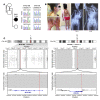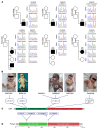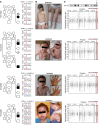Molecular etiology of arthrogryposis in multiple families of mostly Turkish origin
- PMID: 26752647
- PMCID: PMC4731160
- DOI: 10.1172/JCI84457
Molecular etiology of arthrogryposis in multiple families of mostly Turkish origin
Abstract
Background: Arthrogryposis, defined as congenital joint contractures in 2 or more body areas, is a clinical sign rather than a specific disease diagnosis. To date, more than 400 different disorders have been described that present with arthrogryposis, and variants of more than 220 genes have been associated with these disorders; however, the underlying molecular etiology remains unknown in the considerable majority of these cases.
Methods: We performed whole exome sequencing (WES) of 52 patients with clinical presentation of arthrogryposis from 48 different families.
Results: Affected individuals from 17 families (35.4%) had variants in known arthrogryposis-associated genes, including homozygous variants of cholinergic γ nicotinic receptor (CHRNG, 6 subjects) and endothelin converting enzyme-like 1 (ECEL1, 4 subjects). Deleterious variants in candidate arthrogryposis-causing genes (fibrillin 3 [FBN3], myosin IXA [MYO9A], and pleckstrin and Sec7 domain containing 3 [PSD3]) were identified in 3 families (6.2%). Moreover, in 8 families with a homozygous mutation in an arthrogryposis-associated gene, we identified a second locus with either a homozygous or compound heterozygous variant in a candidate gene (myosin binding protein C, fast type [MYBPC2] and vacuolar protein sorting 8 [VPS8], 2 families, 4.2%) or in another disease-associated genes (6 families, 12.5%), indicating a potential mutational burden contributing to disease expression.
Conclusion: In 58.3% of families, the arthrogryposis manifestation could be explained by a molecular diagnosis; however, the molecular etiology in subjects from 20 families remained unsolved by WES. Only 5 of these 20 unrelated subjects had a clinical presentation consistent with amyoplasia; a phenotype not thought to be of genetic origin. Our results indicate that increased use of genome-wide technologies will provide opportunities to better understand genetic models for diseases and molecular mechanisms of genetically heterogeneous disorders, such as arthrogryposis.
Funding: This work was supported in part by US National Human Genome Research Institute (NHGRI)/National Heart, Lung, and Blood Institute (NHLBI) grant U54HG006542 to the Baylor-Hopkins Center for Mendelian Genomics, and US National Institute of Neurological Disorders and Stroke (NINDS) grant R01NS058529 to J.R. Lupski.
Figures








References
Publication types
MeSH terms
Grants and funding
LinkOut - more resources
Full Text Sources
Other Literature Sources
Medical
Molecular Biology Databases

